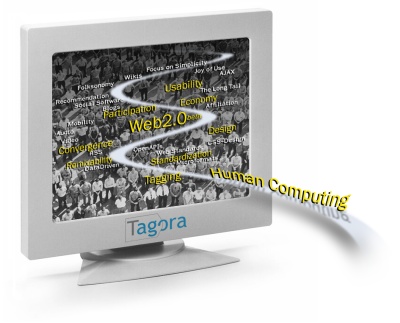
Semiotic Dynamics in Online Social Communities

This is the official website of the TAGora project, a STREP project funded by the European Commission in the framework of the FET proactive initiative “Simulating Emergent Properties in Complex Systems”.
The new paradigms that are gaining momentum in web applications empower users with a new role: users are no longer limited to consuming or creating online content, they also provide the semantic scaffolding holding together such content, thus taking on an active role in shaping the architecture of online information. The collaborative character underlying many Web 2.0 applications puts them in the spotlight of complex systems science, since the problem of linking the low-level scale of user behavior with the high-level scale of global applicative goals is a typical problem tackled by the science of complexity: understanding how an observed emergent structure arises from the activity and interaction of many globally uncoordinated agents. The large number of users involved, together with the fact that their activity is occurring on the web, provide for the first time a unique opportunity to monitor the “microscopic” behavior of users and link it to the high-level features of applications (for example the global properties of a folksonomy) by using formal tools and concepts from the science of complexity.This research project is located at the interface of several fields, such as computer science, complex systems science, cognitive science, psycholinguistics and information architecture, and is likely to feed back into the design of better applications. The project will contribute to Semiotic Dynamics, a new field that studies how semiotic relations can originate, spread, and evolve over time in populations, by combining recent advances in linguistics and cognitive science with methodological and theoretical tools from complex systems and computer science.The TAGora project aims at exploiting the unique opportunities offered by the increasing popularity of computer-mediated social interaction in a variety of contexts. Such popularity, in fact, is making available large amounts of raw data from online semiotic systems (for example, collaborative tagging systems) and these data may become the foundantion of a true scientific investigation about the behavior of human agents on the Web and the dynamics of information in online communities.
The project will develop along several lines:
- A systematic and rigorous data collection campaign that will produce reference datasets and make them available to the scientific community at large.
- The design and implementation of innovative techniques and tools for the analysis and mining of data.
- The construction and validation of modeling schemes for the observed phenomenology, involving the comparison of experimental data, simulation and theoretical constructions.
- The design and deployment of innovative, proof-of-concept tools aimed at better structuring and navigating information.
The project ultimately aims at creating a virtuous cycle between data analysis, modeling and theoretical constructions, with the ultimate goal of understanding, predicting and controlling the Semiotic Dynamics of online social systems.
To learn more about the TAGora project, check out the TAGora Project Presentation report.
The composition of the TAGora Consortium reflects the interdisciplinary nature of the project, bringing together high-quality partners with complementary expertise.
- Physics Department, University of Roma “La Sapienza”, Italy
- Sony Computer Science Laboratory, France
- Institute for Computer Science, University of Koblenz-Landau, Germany
- Knowledge and Data Engineering unit, Department of Mathematics and Computer Science, University of Kassel, Germany
- The School of Electronics and Computer Science, University of Southampton, UK
TAGora project started on June 1st 2006
Sixth Framework Programme, Information Society Technologies, IST call 5, Contract N. 34721
Powered by WordPress |
Entries and comments feeds |
Valid XHTML and CSS